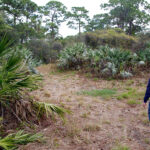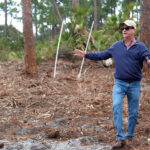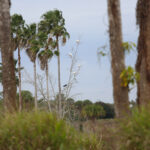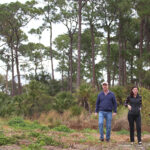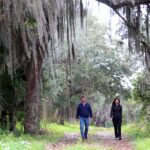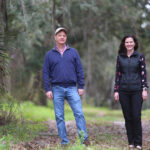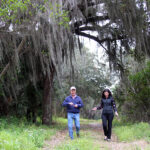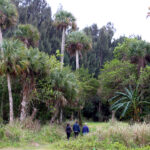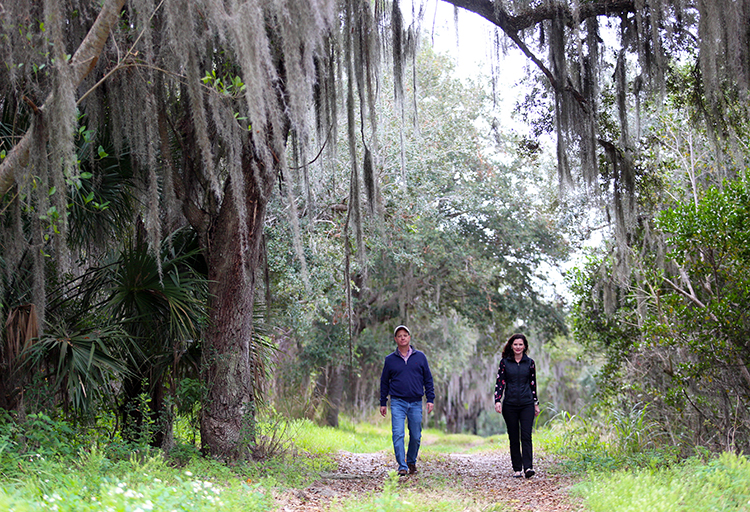
The Indian River Land Trust is moving forward with an ambitious plan to develop a $3.5 million research and education center on its 226-acre Coastal Oaks Preserve property on U.S. Route 1 south of Oslo Road.
Land Trust leaders say the footprint of the project on what they call “an incredible piece of property” will be light, but the impact large and long lasting.
“We are on the verge of submitting our site plan to the county and FDOT, which hopefully will be approved in short order,” said Vero Beach landscape architect Elizabeth Gillick, who chairs the committee overseeing the ecologically sensitive development.
Land Trust executive director Ken Grudens is in talks with a wide range of potential partners interested in operating programs on the property, including the Brevard Zoo, Vero Beach Museum of Art and the Gifford Youth Achievement Center.
Harbor Branch scientists are already working with high school juniors and seniors at the site, teaching field research techniques, and Grudens says the Environmental Learning Center is another area organization that could be part of the mix when the project is complete.
“Coastal Oaks Preserve is a very special place,” said Dennis Hanisak, Harbor Branch Research Professor and Education Director, who runs the Junior Science Fellows program at the site. “It includes one of the few remaining coastal oak hammocks in our area as well as coastal wetlands and other critical habitats.”
Grudens said the property, which stretches for a mile along the Indian River Lagoon, is a complete ecosystem in miniature with “every habitat you can find in the region,” including meadows and forests, fresh and saltwater wetlands, ponds and mangrove forests.
“There is a healthy pine flatwood forest over there,” Grudens said, pointing, during an excursion to the property last week. “Over there is an ancient oak and pine hammock where the trees are hundreds of years old, and there’s another hammock on slightly wetter soil on the other side of the berm that is a mix of pines and palms.”
The pine and palm hammock has a positively fairytale like feel, with a thick carpet of pine needles underfoot and moss and other “air plants” draping trees that have been converting sunlight and soil to oxygen on the shore of the lagoon since before U.S. 1 or Indian River County existed.
Melissa DePriest, who joined the Land Trust staff as director of philanthropy and marketing in November, said the first phase of the project will include a branded entryway with gate and signage, “a new shell rock road and parking area, a gathering pavilion with restrooms and a maintenance and storage building, with connecting boardwalks between the parking area and the pavilion.”
The buildings were designed by architect Peter Moor in a “Florida Vernacular” style, according to Gillick. The pavilion, which is sited at the confluence of a restored freshwater marsh and the oak/pine hammock, will include space for staging research expeditions and conducting educational programs.
“Coastal Oaks Preserve Phase Two will encompass structures – including an over-the-water pavilion – that provide access to the Indian River Lagoon for research and education along the shoreline and interior ponds,” according to DePriest and Grudens.
“Design drawings for the second phase will begin as soon as final plans for Phase One are submitted for site plan approval.”
Gillick said the Land Trust also hopes to clean up a large FDOT retention pond on the site, fitting it into the ecosystem as a water purification resource.
In time, the buildings and boardwalks will blend into the native terrain as new plantings grow up around them, becoming a harmonious part of the natural landscape.
There, scientists from universities and nonprofit organizations will conduct research important to restoring and preserving the lagoon, and generations of students will study ecology and launch their own scientific careers.
“We intend to be very sensitive with our impact on the property,” said Gillick. “We don’t want it to be apparent that we did anything when we are done.”
It could have been much different.
When the Land Trust purchased the first big chunk of Coastal Oaks Preserve years ago, the property was entitled for 545 homes. More recently, a highway frontage strip was slated to be yet another storage facility, stretching for half a mile along U.S. 1.
When it was buying up preservation land in 2007, Indian River County offered the home developer $10 million for the property. He turned that payday down but ended up losing the waterside tract in the housing downturn.
In 2011, at the bottom of the market, the Land Trust stepped in and bought it from the bank for $1.69 million.
In the years since then, it has picked up adjacent parcels – including most recently the 6-acre strip on the west side of U.S. 1 where the storage facility was planned – to accumulate 226 acres.
Those acres are contiguous with more than 100 additional acres of county-owned preserve land that slopes up from the highway and railroad tracks to the historic Hallstrom House.
Grudens said Coastal Oaks Preserve once “was part of the Hallstrom homestead,” and county historian Ruth Stanbridge confirmed that the Hallstroms did indeed own land that extended from their stately home to the lagoon.
“The front 35 acres were an abandoned Hallstrom citrus grove that was heavily overgrown with invasive Brazilian pepper trees, and we weren’t sure how we were going to deal with that,” Grudens said.
“Fortunately, St. Johns River Management needed to do mitigation for a new FDOT interchange on I-95 and they came in and removed all the pepper trees and Australian Pines and restored the marshland.”
In 2015, the Land Trust and Harbor Branch collaborated to create the Junior Science Fellows program.
“We have had about 130 students go through the program and many have gone on to major in various areas of science” in college,” said Hanisak, who has been doing research along the lagoon since 1977.
He joined Harbor Branch during its glory days when it rivaled Woods Hole as an oceanographic institute.
In 2019, as the Land Trust shifted much of its attention from land acquisition to improving the property it had purchased over the previous decade, a committee was formed to “select a landscape architectural firm to create a masterplan and charrette for improving the Coastal Oaks property,” according to Gillick.
The eight-member committee, which Gillick, Moor and Grudens serve on, along with other Land Trust staff, advisors and board members, chose Dix-Hite Landscape Architects for the job.
The firm, with offices in Atlanta, Birmingham and Orlando, aims “to harness the spirit of the land through holistic, intentional and enduring design. With a shared interest in honoring the local environment and celebrating community character, we … work tirelessly to provide sustainable, context-sensitive solutions,” according to its website.
Also in 2019, the Land Trust launched a $10 million capital campaign to fund the project, along with other land improvement and acquisition initiatives.
The campaign has since raised more than $12 million, with $3.5 million earmarked for Coastal Oaks Preserve improvements, according to DePriest.
Some of that dedicated money was used last year to buy the storage facility acreage on the west side of U.S. 1 that links the Land Trust and county land into a 335-acre preserve that Hanisak says “will be protected forever!”
“One of our goals is connectivity,” Gillick said.
“Years from now, when other land along U.S.1 has been developed, the stretch of highway along Coastal Oaks Preserve will remain a green viewshed that provides a peaceful interlude for drivers.”
Gillick said the Coastal Oaks Preserve committee is “a wonderful, thoughtful group of caring people who have given a tremendous amount of time, treasure and knowledge” to the project and will continue to oversee it until completion.
In the meantime, an archeologist is busy studying the history of the land, digging down through the geological layers of time. Marine biologists are doing research on the lifecycle of game fish in the wetlands. Beekeepers are tending their hives along the edges of the hammocks. And Hanisak is training future scientists.
Since it was founded in 2009, the Indian River Land Trust has acquired 1,200 acres of conservation property and 12 miles of lagoon shoreline to fulfill its mission of “protecting the land that protect the lagoon.”
Dix-Hite’s masterplan for Coastal Oaks Preserve can be seen here: www.dixhite.com/projects/coastal-oaks-preserve.
Photos by Kaila Jones

